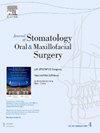影响第三磨牙不同位置的龋病发生率和病理结果:回顾性分析
IF 1.8
3区 医学
Q2 DENTISTRY, ORAL SURGERY & MEDICINE
Journal of Stomatology Oral and Maxillofacial Surgery
Pub Date : 2024-11-06
DOI:10.1016/j.jormas.2024.102137
引用次数: 0
摘要
目的:撞击性第三磨牙(3M)俗称智齿,根据其在颌骨中的位置不同,容易发生龋齿和病变。本研究旨在确定和比较不同位置的阻生第三磨牙的龋齿发生率、病理形态以及下颌阻生第三磨牙的牙根与下颌管的重叠情况:这项回顾性研究对 2019 年至 2023 年期间在托卡特加齐奥斯曼帕萨大学口腔颌面外科就诊的 3M 主诉患者的正侧位片进行了研究。两名研究人员根据 3M 的位置对其进行了独立分类,并对龋齿、病理和神经重叠进行了评估。3Ms 的位置采用佩尔和格雷戈里以及温特的分类法进行分类。主要结果变量是 3M 是否存在龋齿。二级结果变量是 3M 周围是否存在病理形态。三级结果变量是下颌 3M 的牙根与下颌管的重叠情况:研究共纳入了 7038 名患者,其中 53.74% 为女性。平均年龄为(32.15±7.2)岁。上颌和下颌 3Ms 垂直位置的龋病发生率最高(右上颌:9.98%,PC 结论:上颌和下颌 3Ms 垂直位置的龋病发生率最高,PC 结论:上颌和下颌 3Ms 垂直位置的龋病发生率最高:3Ms的位置对龋病和病理形成等并发症的发生起着关键作用。如果牙齿的位置引起并发症的风险较高,则应更认真地考虑预防性拔牙。本文章由计算机程序翻译,如有差异,请以英文原文为准。
Incidence of caries and pathological findings in different positions of impacted third molars: A retrospective analysis
Objectives
Impacted third molars(3 M), commonly known as wisdom teeth, are prone to caries and pathological formations depending on their position in the jaw. This study aimed to determine and compare the incidence of caries, pathological formations, and the superposition of the roots of the mandibular impacted third molar over the mandibular canal in different positions of impacted 3Ms.
Meterials and Methods
This retrospective study was conducted on orthopantomographs of patients who presented with 3 M complaints at the Tokat Gaziosmanpaşa University Oral and Maxillofacial Surgery Department between 2019 and 2023. The 3 M were classified according to their position by two researchers independently and were evaluated for caries, pathology, and nerve superposition. The position of the 3Ms classified using Pell and Gregory and Winter's classifications. The primary outcome variable was the presence of caries in the 3 M The secondary outcome variable was the presence of pathological formations around the 3 M The tertiary outcome variable was the superposition of the roots of the mandibular 3 M over the mandibular canal.
Results
A total of 7,038 patients were included in the study, with 53.74 % being female. The mean age was 32.15±7.2 years. The highest incidence of caries was associated with the vertical position in both maxillary and mandibular 3Ms (right maxillary: 9.98 %, P < 0.001; left maxillary: 12.74 %, P < 0.001; left mandibular: 11.66 %, p = 0.003; right mandibular: 11.69 %, p = 0.031). Pathological formations were most commonly observed in the vertical position, but the highest incidence was found in the horizontal or mesioangular positions (right maxillary: 36.84 %, p < 0.001; left maxillary: 40 %, p < 0.001; left mandibular: 62.04 %, p < 0.001; right mandibular: 62.25 %, p < 0.001). Nerve superposition was most common in the vertical position but was highest in the distoangular position (left mandibular: 74.69 %, p < 0.001; right mandibular: 76.66 %, p < 0.001).
Conclusions
: The position of 3Ms plays a critical role in the development of complications such as caries and pathological formations. Prophylactic extraction may be considered more seriously in cases where the position of the tooth poses a higher risk of complications.
求助全文
通过发布文献求助,成功后即可免费获取论文全文。
去求助
来源期刊

Journal of Stomatology Oral and Maxillofacial Surgery
Surgery, Dentistry, Oral Surgery and Medicine, Otorhinolaryngology and Facial Plastic Surgery
CiteScore
2.30
自引率
9.10%
发文量
0
审稿时长
23 days
 求助内容:
求助内容: 应助结果提醒方式:
应助结果提醒方式:


